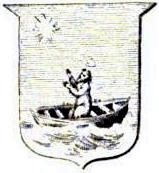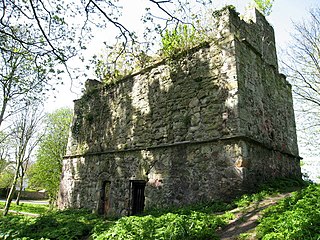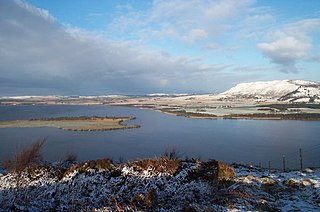Related Research Articles

The Bishop of the Isles or Bishop of Sodor was the ecclesiastical head of the Diocese of the Isles, one of Scotland's thirteen medieval bishoprics. The bishopric, encompassing both the Hebrides and Mann, probably traces its origins as an ecclesiastical unity to the careers of Olaf, King of the Isles, and Bishop Wimund. Previously, there had been numerous bishoprics, and recorded bishoprics include Kingarth, Iona, Skye and Mann. There were very likely numerous others.
Donald Elmslie Robertson Watt FRSE was a Scottish historian and Professor Emeritus at St Andrews University.
The Dean of Moray was the head of the cathedral chapter of the diocese of Moray, north-central Scotland, based at Elgin Cathedral. The diocese of Moray is first known to have had a dean from a document dating between 1207 and 1208, and its first dean known by name from a document dating between 1207 and 1211. The position remained in existence until the 17th century.
Richard de Pontefract O. P. was an English Dominican friar active during the reign King Edward II. On 25 June 1320, King Edward petitioned the papacy for Richard to fill the see of Dunblane, vacant by the death of Nicholas de Balmyle. Although King Edward probably did not expect to have much luck, because of the circumstances of Wars of Scottish Independence, Edward claimed the right of patronage to Scottish sees. The vacant bishopric was eventually filled by Maurice, the Abbot of Inchaffray.
William O. Tiron. was a late 13th-century Tironensian abbot and bishop in the Kingdom of Scotland. He appears in the extant sources for the first time on 25 April 1276; he is Abbot of Arbroath. According to the Scotichronicon, the work of the 15th-century historian Walter Bower, William's predecessor Adam de Inverlunan had died in 1275, so William probably became abbot in either that year or in 1276.
Jonathan was a churchman and prelate active in late twelfth- and early thirteenth century Strathearn, in the Kingdom of Scotland. He was the Bishop of Dunblane during the time of Gille Brigte of Strathearn, and it was during Jonathan's episcopate that Gille Brigte founded an Augustinian priory at Inchaffray.
John Spalding was a 15th-century churchman based at Brechin in Angus, Scotland. Spalding became Dean of Brechin in 1456; he was confirmed in this position by the Pope on 5 October 1458.
Andrew Graham was Bishop of Dunblane between 1573 and 1594.
John Porterfield was a Scottish prelate in the sixteenth-century. A mysterious figure, he emerges in 1571 as the successor to James Beaton II as Archbishop of Glasgow. He was described by Robert Keith as "a kind of titular bishop", propped up by the establishment for nominal purposes during a period of disorder. Porterfield probably held on to the archbishopric into 1572, but he disappeared from the records thereafter. In late 1573, James Boyd of Trochrig became new Archbishop of Glasgow. Porterfield is possibly the John Porterfield, minister of Ayr, who died in 1604 to be succeeded by John Welsh.
Thomas de Rossy was a fourteenth-century Scottish prelate. He appears in the historical record for the first time in 1331, when Pope John XXII provided him to succeed Bernard as Bishop of the Isles. At this stage, the papal sources name him as a canon of Dunkeld Cathedral.
The Archdeacon of Argyll was the only archdeacon in the diocese of Argyll, acting as a subordinate of the Bishop of Argyll. Regarding his supporting churches, it is known that archdeacon held a quarter of parish church of Eilean Munde as a prebend.
Adalbert was an 11th-century prelate. Having been consecrated elsewhere, he is said by the Saxon writer Adam of Bremen to have been sent to become Bishop of Orkney by his namesake, Adalbert, Archbishop of Hamburg. He is mentioned as the successor of Bishop John.
The Archdeacon of the Isles was the only archdeacon in the diocese of the Isles, acting as a subordinate of the Bishop of the Isles. The number and names of the prebends, if any, associated with the archdeaconry in the later Middle Ages are not known. Before the break-away of the diocese of Man during the Western Schism, the archdeacons held Kirk Andreas as a prebend. The office seems to have fallen into disuse after the time of Alasdair Caimbeul, who received crown presentation to the position in 1592. It was to be revived in 1662.

Robert I or Robert of Nostell was a 12th-century Anglo-Norman Augustinian churchman, the first prior of St Andrews.

St. Mary's Priory, North Berwick, was a monastery of nuns in medieval East Lothian, Scotland. Founded by Donnchad I, Earl of Fife around 1150, the priory lasted for more than four centuries, declining and disappearing after the Scottish Reformation. It had been endowed by the Earls of Carrick as well as the Earls of Fife, but over time lost its dependence on these and came to be controlled by the more locally based Home family, who eventually acquired the priory's lands as a free barony.
Walter I was a 12th-century Augustinian Anglo-Norman prelate active in the kingdom of Scotland.
Gilbert was a 12th-century Augustinian canon. Active in Scotland, he may have been of Anglo-Norman origin.
Thomas was an Augustinian canon and Cistercian monk in 13th-century Scotland. According to Walter Bower Thomas was sub-prior of St Andrews Cathedral Priory when he became prior of St Andrews, sometime in 1199. He appears as prior in contemporary documents for the first time on 6 June 1199.

Simon was a 13th-century Augustinian canon based in the Kingdom of Scotland.
Adam of Harcarse was a 13th-century Cistercian Abott. He served as Abbot of Newbattle between 1216 and 1219 and then Abbot of Melrose from 1219 until his death in 1245.
References
- ↑ "OSCR | Charity Details". www.oscr.org.uk.
- ↑ "Archived copy" (PDF). Archived from the original (PDF) on 7 August 2012. Retrieved 25 September 2012.
{{cite web}}: CS1 maint: archived copy as title (link) - ↑ Carruthers, Gerard; MacDonald, Catriona M. M. (2013). "Fictive Pasts and Past Fictions". Scottish Historical Review. 92 (234): 137–166. doi:10.3366/shr.2013.0171. JSTOR 43773987.
- ↑ "Publications". Scottish Record Society.